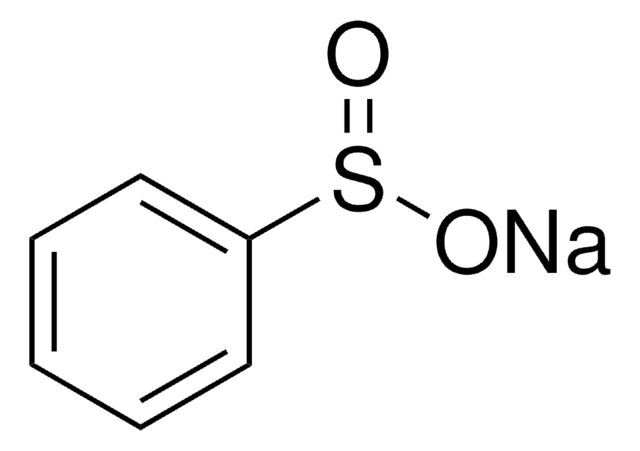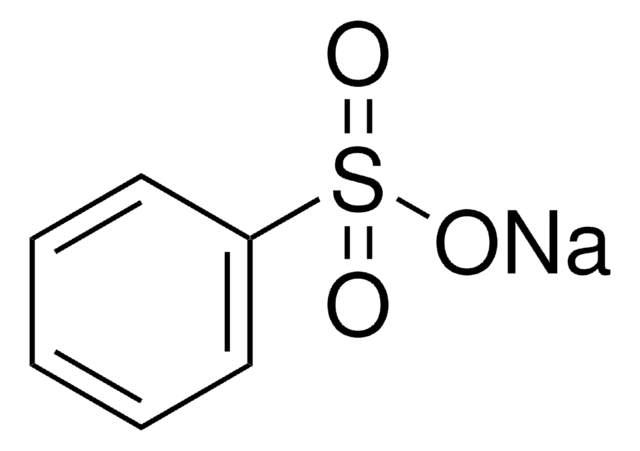All Photos(3)
About This Item
Linear Formula:
C6H5SO3H
CAS Number:
Molecular Weight:
158.18
Beilstein/REAXYS Number:
742513
MDL number:
UNSPSC Code:
12352106
PubChem Substance ID:
NACRES:
NA.22
Recommended Products
grade
technical grade
Quality Level
assay
90%
form
solid
functional group
sulfonic acid
SMILES string
OS(=O)(=O)c1ccccc1
InChI
1S/C6H6O3S/c7-10(8,9)6-4-2-1-3-5-6/h1-5H,(H,7,8,9)
InChI key
SRSXLGNVWSONIS-UHFFFAOYSA-N
Looking for similar products? Visit Product Comparison Guide
General description
Benzenesulfonic acid, also known as besylic acid, is a strong organic acid commonly used as an acid catalyst in various organic reactions, such as esterification, alkylation, and condensation reactions. It is also used as a sulfonating agent to introduce sulfonic acid (SO3H) groups into organic compounds, which can be useful in the synthesis of several dye intermediates.
signalword
Danger
hcodes
Hazard Classifications
Acute Tox. 4 Oral - Eye Dam. 1 - Met. Corr. 1 - Skin Corr. 1B
Storage Class
8A - Combustible corrosive hazardous materials
wgk_germany
WGK 1
flash_point_f
Not applicable
flash_point_c
Not applicable
Choose from one of the most recent versions:
Already Own This Product?
Find documentation for the products that you have recently purchased in the Document Library.
Customers Also Viewed
Wen Huang et al.
The Journal of organic chemistry, 73(17), 6845-6848 (2008-08-07)
A novel, convenient, and efficient method has been developed for selective synthesis of spirocycle, polycycle, and di- and tetrahydronaphthalene systems from aryl-substituted propargylic alcohols by FeCl3- or TsOH-catalyzed multiple activations of unsaturated C-C bonds and C-H bonds.
Ramasubbu Ramani et al.
Biomacromolecules, 9(5), 1390-1397 (2008-04-19)
We present lamellar self-assembly of cationic poly(L-histidine) (PLH) stoichiometrically complexed with an anionic surfactant, dodecyl benzenesulfonic acid (DBSA), which allows a stabilized conformation reminiscent of polyproline type II (PPII) left-handed helices. Such a conformation has no intrapeptide hydrogen bonds, and
Wenyi Huang et al.
ACS nano, 6(11), 10178-10185 (2012-10-27)
High-performance graphene nanopapers are prepared from an aqueous solution of functional graphenes with benzenesulfonic acid groups via covalent bonds. The formed hydrophobic graphene nanopapers showed the highest tensile strength of 360 MPa and Young's modulus of 102 GPa for samples
Garry D Sisk et al.
Electrophoresis, 30(19), 3366-3371 (2009-09-04)
In this research, ion transfer across the interface between two immiscible electrolyte solutions (ITIES) was used as a method of detection in a CE separation system. This method allows for the electrochemical detection of ionic analytes that cannot be easily
Wang-Ping Ting et al.
Journal of hazardous materials, 156(1-3), 421-427 (2008-02-05)
A new approach for promoting ferric reduction efficiency using a different electrochemical cell and the photoelectro-Fenton process has been developed. The use of UVA light and electric current as electron donors can efficiently initiate the Fenton reaction. Benzene sulfonic acid
Our team of scientists has experience in all areas of research including Life Science, Material Science, Chemical Synthesis, Chromatography, Analytical and many others.
Contact Technical Service










